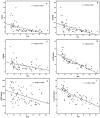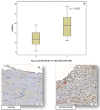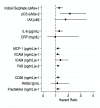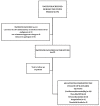The Impact of Uremic Toxicity Induced Inflammatory Response on the Cardiovascular Burden in Chronic Kidney Disease
- PMID: 30249039
- PMCID: PMC6215310
- DOI: 10.3390/toxins10100384
The Impact of Uremic Toxicity Induced Inflammatory Response on the Cardiovascular Burden in Chronic Kidney Disease
Abstract
Uremic toxin (UT) retention in chronic kidney disease (CKD) affects biological systems. We aimed to identify the associations between UT, inflammatory biomarkers and biomarkers of the uremic cardiovascular response (BUCVR) and their impact on cardiovascular status as well as their roles as predictors of outcome in CKD patients. CKD patients stages 3, 4 and 5 (n = 67) were recruited and UT (indoxyl sulfate/IS, p-cresil sulfate/pCS and indole-3-acetic acid/IAA); inflammatory biomarkers [Interleukin-6 (IL-6), high sensitivity C reactive protein (hsCRP), monocyte chemoattractant protein-1 (MCP-1), soluble vascular adhesion molecule-1 (sVCAM-1), soluble intercellular adhesion molecule-1 (sICAM-1) and soluble Fas (sFas)] and BUCVRs [soluble CD36 (sCD36), soluble receptor for advanced glycation end products (sRAGE), fractalkine] was measured. Patients were followed for 5.2 years and all causes of death was used as the primary outcome. Artery segments collected at the moment of transplantation were used for the immunohistochemistry analysis in a separate cohort. Estimated glomerular filtration rate (eGFR), circulating UT, plasma biomarkers of systemic and vascular inflammation and BUCVR were strongly interrelated. Patients with plaque presented higher signs of UT-induced inflammation and arteries from CKD patients presented higher fractalkine receptor (CX3CR1) tissue expression. Circulating IS (p = 0.03), pCS (p = 0.007), IL-6 (p = 0.026), sFas (p = 0.001), sCD36 (p = 0.01) and fractalkine (p = 0.02) were independent predictors of total mortality risk in CKD patients. Our results reinforce the important role of uremic toxicity in the pathogenesis of cardiovascular disease (CVD) in CKD patients through an inflammatory pathway.
Keywords: fractalkine (CX3CL1); fractalkine receptor (CX3CR1); inflammatory biomarkers; sCD36; sRAGE; uremic toxins.
Conflict of interest statement
The authors declare no conflict of interest.
Figures




References
-
- Stenvinkel P., Ketteler M., Johnson R.J., Lindholm B., Pecoits-Filho R., Riella M., Heimbürger O., Cederholm T., Girndt M. IL-10, IL-6, and TNF-alpha: Central factors in the altered cytokine network of uremia--the good, the bad, and the ugly. Kidney Int. 2005;67:1216–1233. doi: 10.1111/j.1523-1755.2005.00200.x. - DOI - PubMed
Publication types
MeSH terms
Substances
LinkOut - more resources
Full Text Sources
Other Literature Sources
Medical
Research Materials
Miscellaneous

